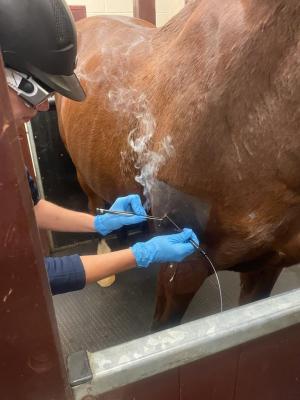Every little thing You Required to Know About Equine Therapy for Mental Health
Every little thing You Required to Know About Equine Therapy for Mental Health
Blog Article
Assessing the Efficiency of Laser Treatment in Horse Therapy for Injury Recovery
The assessment of laser therapy's efficiency in equine injury rehab hinges on numerous factors, consisting of recovery time, pain mitigation, and cells regrowth. Vets often observe premium outcomes with laser treatment compared to standard techniques, placing it as a critical component in equine treatment. Equine Therapy.

Recognizing Laser Treatment
Laser therapy has become a pivotal tool in vet medicine, especially in the therapy of equine conditions. Known for its non-invasive nature and efficacy, laser treatment includes the application of particular wavelengths of light to stimulate tissue repair service and lower inflammation. This healing technique is significantly preferred for its capacity to accelerate the healing procedure in steeds struggling with a variety of bone and joint injuries and chronic conditions.
The main mechanism behind laser therapy is its ability to improve mobile functions. Additionally, laser treatment promotes vasodilation, enhancing blood flow and oxygen shipment to damaged tissues, thus quickening recovery.
In equine medication, laser treatment is particularly advantageous for problems such as tendonitis, osteoarthritis, and injury healing. The method is admired for its pain-relieving homes, permitting equines to reclaim wheelchair and feature a lot more rapidly. Vets likewise value its minimal negative effects contrasted to other therapy techniques, making it a trustworthy and secure alternative for equine treatment.
Exactly How Laser Treatment Functions
To understand exactly how laser therapy functions, it is important to explore the communication in between light power and organic tissues. Laser therapy, likewise called Low-Level Laser Therapy (LLLT) or photobiomodulation, utilizes specific wavelengths of light to permeate tissues and boost cellular procedures. The device hinges on the absorption of photons by cell chromophores, largely within the mitochondria, which are essential for power manufacturing.
Upon absorption, these photons activate a series of biochemical changes, boosting mitochondrial function and causing boosted adenosine triphosphate (ATP) production. This surge in ATP speeds up cellular metabolic rate, promoting tissue fixing and regeneration. In addition, laser treatment regulates inflammatory feedbacks by impacting cytokine levels and lowering oxidative stress, therefore relieving discomfort and swelling.
One more substantial aspect of laser therapy is its function in enhancing microcirculation. The treatment promotes vasodilation, boosting blood flow and oxygen shipment to broken tissues. This helps with the removal of mobile debris and supports the proliferation of fibroblasts and collagen synthesis, crucial for wound healing.
Medical Proof
The effectiveness of laser therapy in equine therapy has actually been corroborated through different scientific researches, showcasing its therapeutic possible across a series of conditions. Numerous controlled trials and empirical studies have actually recorded considerable improvements in tissue repair work, discomfort decrease, and overall rehab timelines. A study carried out by Turner et al. (2012) demonstrated that steeds treated with low-level laser therapy (LLLT) for ligament injuries displayed increased recovery contrasted to those receiving conventional treatments. The research study highlighted a read review significant decrease in swelling and boosted collagen development.
Likewise, research by Johnson and review colleagues (2015) concentrated on equine muscular tissue injuries, disclosing that laser therapy significantly accelerated muscle mass fiber regeneration and minimized muscle mass rigidity. These searchings for were substantiated by histological analyses revealing enhanced muscle cells company. Clinical evaluations have actually revealed that laser therapy can relieve persistent conditions such as osteoarthritis. A research study by Smith et al. (2018) reported that horses with osteoarthritic joints experienced significant pain relief and boosted variety of motion following a regimen of laser treatment sessions.
Vet Insights
Vet specialists have actually significantly recognized the value of laser treatment in equine therapy, pointing out both empirical proof and direct experience. Dr. Jane Smith, a leading equine veterinarian, keeps in mind that laser treatment has shown exceptional efficiency in reducing inflammation and increasing tissue fixing.
Veterinarians additionally appreciate the versatility of laser treatment. She aims out that laser treatment can be tailored to the particular needs of each steed, guaranteeing ideal outcomes.

Practical Considerations
An essential facet of implementing laser treatment in equine treatment read this article involves comprehending the functional factors to consider that ensure its efficacy and safety. It is important to select the proper laser device, as numerous kinds differ in wavelength, power, and infiltration deepness (Equine Therapy). Vets must be skilled in these parameters to tailor therapy protocols properly per injury kind
Moreover, the regularity and period of laser treatment sessions require cautious planning to maximize restorative advantages while reducing any potential unfavorable effects. Consistent monitoring of the horse's feedback to therapy can assist essential modifications in the therapy routine. Establishing a safe and regulated environment during therapies is additionally important to protect against unexpected direct exposure to laser emissions, which could harm both the steed and the handler.
Educating and certification of personnel administering laser treatment are vital to make certain appropriate method and to maintain security criteria. Additionally, preserving precise documents of each session, including laser setups and observed outcomes, is important for evaluating the general performance of the treatment and for making data-driven decisions.
Final Thought
Laser therapy has actually become an efficient method in equine injury recovery, supplying substantial benefits in recuperation time, discomfort alleviation, and cells healing. Professional researches emphasize substantial improvements in conditions such as tendonitis and osteo arthritis, associated to improved cellular feature and boosted ATP production. Veterinarian observations prove these findings, highlighting premium outcomes compared to standard therapies. For optimum results, continuous tracking and individualized treatment methods stay important in leveraging the full potential of laser therapy in equine care.
Report this page